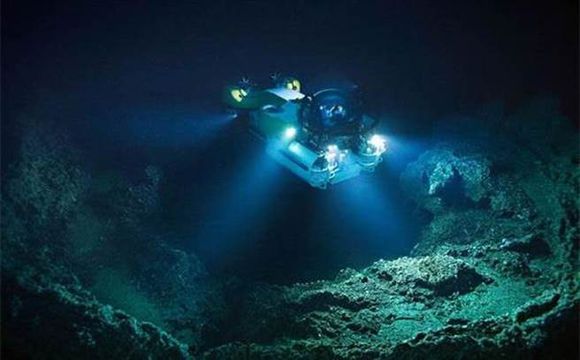(单词翻译:单击)
听力文本
This is Scientific American — 60-Second Science. I'm Julia Rosen.
Got a minute?
The Mariana Trench is the deepest spot in the world's oceans. Only three humans have ventured into the trench in submersibles. But plenty of our pollution has made the voyage to the bottom of the sea: a new study finds that critters living more than six miles below the ocean surface contain high levels of harmful compounds like polychlorinated biphenyls, or PCBs, and flame retardants.
"An important thing is that, if you're in the deepest place in world, there's no place to go."
Alan Jamieson, a marine ecologist at Newcastle University in the U.K.
"You can't be disturbed horizontally. You can't go back up. So, for every nanogram of pollutant that's gone into the deep sea, there's no mechanism to put it back again. So, of course the values are going to be high, cause it's only a one way traffic, right?"
Jamieson and his colleagues used robotic traps to collect deep-sea amphipods living in the most remote parts of the oceans. These creatures look a bit like shrimp, and they're well adapted to their extreme environment, he says.

"The deep sea-ones are incredible scavengers. This is why they thrive in the deep sea, because it's a low-food environment where most of their food comes from dead carcasses raining from the surface or particulates coming down. So, everything from an organic particle to a dead whale is fair game to an amphipod."
The food that floats down to the ocean bottom carries man-made contaminants, including PCBs, which entered the surface ocean from rivers and coastlines. Companies stopped manufacturing these chemicals in the 1970s, after they were found to be dangerous. But they don't break down easily, so they're still swirling around in the oceans and working their way down to the seafloor, where amphipods gobble them up.
The research was published in the journal Nature Ecology and Evolution.
In many surface-dwelling species, PCBs have been shown to interfere with animals' abilities to reproduce. Jamieson says they don't have enough data yet to know how deep-sea amphipods are faring, because they're much harder to study. But he says that wasn't his motivation for studying pollutants in the deep ocean.
"The point is that they are there. It's to challenge people's perception that the deep sea is not exempt from what's happening in the rest of the world. And that's a perception we hear quite a lot of."
Thanks for listening for Scientific American — 60-Second Science Science. I'm Julia Rosen.
参考译文
这里是科学美国人——60秒科学。我是朱莉娅·罗森。
有一分钟时间吗?
马里亚纳海沟是世界海洋最深处。截至目前,只有三个人曾乘坐潜水器冒险进入那里。但是,人类制造的污染物却到达了那片海底:一项新研究发现,生活在海面下六英里的生物体内含有高浓度有害化合物,包括多氯联苯(简称PCB)和阻燃剂等。
“问题是,如果污染物到达世界上最深的地方,那就没有什么地方可去了。”
英国纽卡斯尔大学的海洋生态学家艾伦·杰米森说。
“污染物无法被水平搅动扩散,也不能回到海面上去。因此,到达深海的污染物,连一纳克都无法重返海面,没有任何机制能做到。当然,这样污染值就会升高,因为污染物只能下沉,是这样吧?”
杰米森和同事用机器陷阱捕捉了生活在海洋最偏远地区的深海片脚类动物。他说,这些生物看起来有点像虾,它们很好地适应了极端环境。
“深海片脚类动物是不可思议的清道夫。这就是它们能在深海繁衍生息的原因,因为它们所处的地方属于低食物环境,而它们的食物大多来自于海面沉降的尸体或微粒。所以,从有机颗粒到死鲸尸体,这一切都会成为片脚类动物的美食。”
它们的食物携带着人类制造的污染物漂至海洋底部,包括多氯联苯在内的污染物从河流和海岸线进入海面。在发现这些物质有害后,各家企业在上世纪70年代停止了这些化学物质的生产。但是这些物质不易分解,所以它们仍然在海洋里环游并沉入海底,然后在海底被那片脚类动物吃掉。
这项研究发表在《自然生态和进化》期刊上。
多氯联苯对很多海面物种的繁殖能力产生了影响。杰米森表示,目前他们没有掌握足够的数据,不能说明深海片脚类动物是如何生存的,因为这种动物很难研究。不过,他也表示,这并不是他研究深海污染物的动机。
“关键在于深海存在污染物。深海没能避免世界其他地方所遭遇的污染,这对人们此前的看法提出了挑战。而这也是人们经常提到的看法。”
谢谢大家收听科学美国人——60秒科学。我是朱莉娅·罗森。
译文为可可英语翻译,未经授权请勿转载!
重点讲解
重点讲解:
1. break down (使)(物质)分解;
例句:Over time, the protein in the eggshell breaks down into its constituent amino acids.
时间久了,蛋壳中的蛋白质就会分解为其构成成分氨基酸。
2. gobble up 吞并;
例句:As he was still hungry, he gobbled up a second sandwich.
因为还饿,他又狼吞虎咽地吃了第二块三明治。
3. interfere with 妨碍;冲突;抵触;
例句:He was afraid this would interfere with his study.
他担心这会妨碍他的学习。
4. be exempt from 被免除的;被豁免的;
例句:He is exempt from punishment about this thing.
关于此事对他已免于处分。


